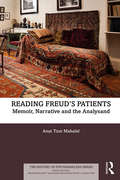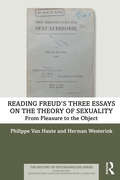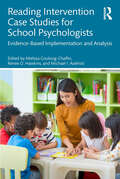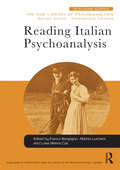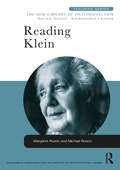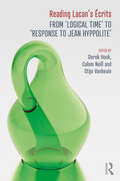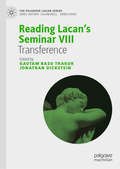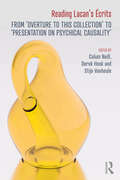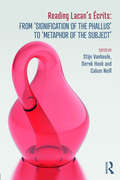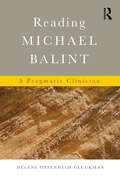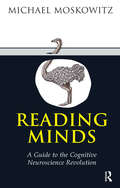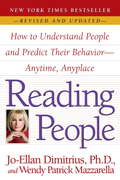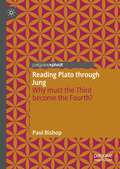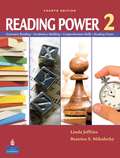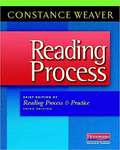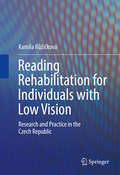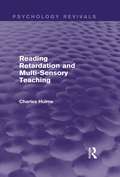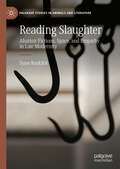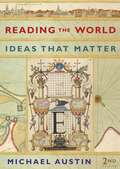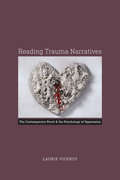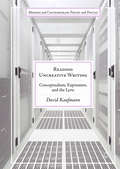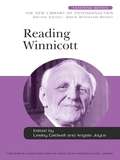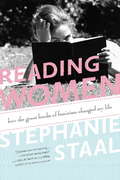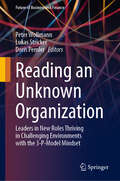- Table View
- List View
Reading Freud’s Patients: Memoir, Narrative and the Analysand (The History of Psychoanalysis Series)
by Anat Tzur MahalelWhat would the story of analysis look like if it were told through the eyes of the analysand? How would the patient write and present the analytic experience? How would the narrative as written by the analysand differ from the analytic narrative commonly offered by the analyst? What do the actual analytic narratives written by Freud’s patients look like? This book aims to confront these intriguing questions with an innovative reading of memoirs by Freud’s patients. These patients—including Sergei Pankejeff, known as the Wolf Man; the poet H. D.; and the American psychoanalyst Abram Kardiner—all came to Vienna specially to meet Freud and embark with him on the intimate and thrilling journey of deciphering the unconscious and unravelling the secrets of the psyche. A broad psychoanalytic and literary-historical reading of their memoirs is offered in this new entry to the popular Routledge History of Psychoanalysis Series, with the purpose of presenting the analysands' narratives as they themselves recounted them. This makes it possible to re-examine the links among psychoanalysis, literature, and translation and sheds new light on the complex challenge of coming to know oneself through the encounter with otherness. This book is unique in its focus on multiple memoirs by patients of Freud and presents a fresh, even startling, close-up look at psychoanalysis as a clinical practice and as a rigorous discourse and offers a new vision of Freud’s strengths and, at times, defects. It will be of considerable interest to scholars of psychoanalysis and intellectual history, as well as those with a wider interest in literature and memoir.
Reading Freud’s Three Essays on the Theory of Sexuality: From Pleasure to the Object (The History of Psychoanalysis Series)
by Herman Westerink Philippe Van HauteSigmund Freud’s 1905 Three Essays on the Theory of Sexuality is a founding text of psychoanalysis and yet it remains to a large extent an "unknown" text. In this book Freud’s 1905 theory of sexuality is reconstructed in its historical context, its systematic outline, and its actual relevance. This reconstruction reveals a non-oedipal theory of sexuality defined in terms of autoerotic, non-objectal, physical-pleasurable activities originating from the "drive" and the excitability of erogenous zones. This book, consequently, not only calls for a reconsideration of the development of Freudian thinking and of the status of the Oedipus complex in psychoanalysis but also has a strong potential for supporting contemporary non-heteronormative theories of sexuality. It is as such that the 1905 edition of Three Essays becomes a highly relevant document in contemporary philosophical discussions of sexuality. This book also explores the inconsistencies and problems in the original theory of sexuality, notably the unresolved question of the transition from autoerotic infantile sexuality to objectal adult sexuality, as well as the theoretical and methodological shifts present in later editions of Three Essays. It will be of great interest to psychoanalysts and those with an academic interest in the history of psychoanalysis and sexuality.
Reading Intervention Case Studies for School Psychologists: Evidence-Based Implementation and Analysis
by Michael I. Axelrod Melissa Coolong-Chaffin Renee O. HawkinsReading Intervention Case Studies for School Psychologists provides vivid, real-world examples of school-based interventions targeting students’ phonological awareness, phonics, fluency, and comprehension in reading. This book offers a rich variety of applied reading interventions in school settings , spanning strategies such as incidental teaching, word boxes, peer tutoring, taped words, story mapping, and beyond. Each case includes thorough descriptions of the specific area of concern, detailed intervention protocols, data collection and analysis methods, and tips for ensuring social acceptability and treatment integrity. School psychologists, along with related professionals in special education, general education, and speech-language pathology, will come away with new insights into this comprehensive set of well-researched and frequently applied reading interventions.
Reading Italian Psychoanalysis (New Library of Psychoanalysis Teaching Series)
by Franco Borgogno Alberto Luchetti Luisa Marino CoeWinner of the American Board & Academy of Psychoanalysis Prize for best Edited book published in 2016 Psychoanalysis in Italy is a particularly diverse and vibrant profession, embracing a number of influences and schools of thought, connecting together new thinking, and producing theorists and clinicians of global renown. Reading Italian Psychoanalysis provides a comprehensive guide to the most important Italian psychoanalytic thinking of recent years, including work by major names such as Weiss, E.Gaddini, Matte Blanco, Nissim Momigliano, Canestri, Amati Mehler, and Ferro. It covers the most important theoretical developments and clinical advances, with special emphasis on contemporary topics such as transference, trauma and primitive states of mind where Italian work has been particular influential. In this volume, Franco Borgogno, Alberto Luchetti and Luisa Marino Coe of the Italian Psychoanalytical Society provide an overview of how Italian psychoanalysis has developed from the 1920’s to the present day, tracing its early influences and highlighting contemporary developments. Forty-six seminal and representative papers of psychoanalysts belonging to the two Italian psychoanalytical societies (the Italian Psychoanalytical Society and the Italian Association of Psychoanalysis) have been chosen to illuminate what is special about Italian theoretical and clinical thinking, and what is demonstrative of the specificity of its psychoanalytic discourse. The selected papers are preceded by a first introductory section about the history of psychoanalysis in Italy and followed by a "swift glance at Italian psychoanalysis from abroad". They are grouped into sections which represent the areas particularly explored by Italian psychoanalysis. Each section is accompanied by introductory comments which summarize the main ideas and concepts and also their historical and cultural background, so as to offer to the reader either an orientation and stimulus for the debate and to indicate their connections to other papers included in the present volume and to the international psychoanalytic world. The book is divided into six parts including: History of psychoanalysis in Italy Metapsychology Clinical practice, theory of technique, therapeutic factors The person of the analyst, countertransference and the analytic relationship/field Trauma, psychic pain, mourning and working-through Preverbal, precocious, fusional, primitive states of the mind This volume offers an excellent and detailed "fresco" of Italian psychoanalytic debate, shining a light on thinking that has evolved differently in France, England, North and Latin America. It is an ideal book for beginners and advanced students of clinical theory as well as experienced psychoanalysts wanting to know more about Italian psychoanalytic theory and technique, and how they have developed.
Reading Klein (New Library of Psychoanalysis Teaching Series)
by Michael Rustin Margaret RustinReading Klein provides an introduction to the work of one of the twentieth century’s greatest psychoanalysts, known in particular for her contribution in developing child analysis and for her vivid depiction of the inner world. This book makes Melanie Klein’s works highly accessible, providing both substantial extracts from her writings, and commentaries by the authors exploring their significance. Each chapter corresponds to a major field of Klein’s work outlining its development over almost 40 years. The first part is concerned with her theoretical and clinical contributions. It shows Klein to be a sensitive clinician deeply concerned for her patients, and with a remarkable capacity to understand their unconscious anxieties and to revise our understanding of the mind. The second part sets out the contribution of her ideas to morality, to aesthetics and to the understanding of society, introducing writing by her associates as well as herself. The book provides a lucid account of Klein’s published writing, presented by two distinguished writers who know her work well and have made creative use of it in their own clinical and extra-clinical writing. Its aim is to show how substantial her contribution to psychoanalytic thinking and clinical practice was, and how indispensable it remains to understanding the field of psychoanalysis. Reading Klein will be a highly valuable resource for students, trainees in psychoanalysis, psychoanalytic practitioners and all who are interested in Melanie Klein and her legacy.
Reading Lacan's Écrits: From ‘Logical Time’ to ‘Response to Jean Hyppolite’
by Derek HookReading Lacan’s Écrits is the first extensive set of commentaries on the complete edition of Lacan’s Écrits to be published in English. This third volume provides an indispensable companion piece to some of Lacan’s most crucial and notoriously challenging writings, from ‘Logical Time’ to ‘Response to Jean Hyppolite’, and including ‘The Function and Field of Speech’, ‘Variations on the Standard Treatment’ and ‘Presentation on Transference’. With the contributions of some of the world’s most renowned Lacanian scholars and analysts – such as Bernard Burgoyne, Marc De Kesel and Russell Grigg – this volume encompasses a series of systematic, paragraph-by-paragraph commentaries which not only contextualize, explain and interrogate Lacan’s arguments, but afford the reader multiple interpretive routes through the complete edition of Lacan’s most labyrinthine of texts. As there is no existing set of exhaustive commentaries on Lacan’s Écrits available in English, this volume acts as an essential and incisive reference-text for psychoanalysts and psychoanalytic psychotherapists in training and in practice, as well as philosophers, cultural theorists and literary, social science and humanities researchers. Considering the significance of Écrits as a landmark in the history of psychoanalysis, this far-reaching and accessible guide will sustain and continue to animate critical engagement with one of the most challenging intellectual works of the twentieth century.
Reading Lacan's Écrits: From ‘The Freudian Thing’ to 'Remarks on Daniel Lagache'
by Derek Hook Calum Neill Stijn VanheuleThe Écrits was Jacques Lacan’s single most important text, a landmark in psychoanalysis which epitomized his aim of returning to Freud via structural linguistics, philosophy and literature. Reading Lacan’s Écrits is the first extensive set of commentaries on the complete edition of Lacan’s Écrits to be published in English. An invaluable document in the history of psychoanalysis, and one of the most challenging intellectual works of the 20th Century, Lacan’s Écrits still today begs the interpretative engagement of clinicians, scholars, philosophers and cultural theorists. The three volumes of Reading Lacan’s Écrits offer just this: a series of systematic paragraph-by-paragraph commentaries – by some of the world’s most renowned Lacanian analysts and scholars – on the complete edition of the Écrits, inclusive of lesser known articles such as ‘Kant with Sade’, ‘The Youth of Gide’, ‘Science and Truth’, ‘Presentation on Transference’ and ‘Beyond the "Reality Principle"'. The originality and importance of Lacan’s Écrits to psychoanalysis and intellectual history is matched only by the text’s notorious inaccessibility. Reading Lacan’s Écrits is an indispensable companion piece and reference-text for clinicians and scholars exploring Lacan's magnum opus. Not only does it contextualize, explain and interrogate Lacan's arguments, it provides multiple interpretative routes through this most labyrinthine of texts. Reading Lacan’s Écrits provides an incisive and accessible companion for psychoanalysts and psychoanalytic psychotherapists in training and in practice, as well as philosophers, cultural theorists and literary, social science and humanities researchers who wish to draw upon Lacan’s pivotal work.
Reading Lacan’s Seminar VIII: Transference (The Palgrave Lacan Series)
by Gautam Basu Thakur Jonathan DicksteinThis book provides 18 lively commentaries on Lacan’s Seminar VIII, Transference (1960-61) that explore its theoretical and philosophical consequences in the clinic, the classroom, and society. Including contributions from clinicians as well as scholars working in philosophy, literature, and culture studies, the commentaries presented here represent a wide-range of disciplinary perspectives on the concept of transference. Some chapters closely follow the structure of the seminar’s sessions, while others take up thematic concerns or related sessions such as the commentary on sessions 19 to 22 which deal with Lacan’s discussion of Claudel’s Coûfontaine trilogy. This book is not a compendium to Lacan’s seminar. Instead it attempts to capture through shorter contributions a spectrum of voices debating, deliberating, and learning with Lacan’s concept. In doing so it can be seen to engage with transference conceptually in a manner that matches the spirit of Lacan’s seminar itself.The book will provide an invaluable new resource for Lacan scholars working across the fields of psychoanalytic theory, clinical psychology, philosophy and cultural studies.
Reading Lacan’s Écrits: From ‘Overture to this Collection’ to ‘Presentation on Psychical Causality’
by Calum Neill, Derek Hook and Stijn VanheuleReading Lacan's Écrits is the first extensive set of commentaries on the complete edition of Lacan's Écrits to be published in English, providing an indispensable companion piece to some of Lacan's best-known but notoriously challenging writings.With the contributions of some of the world's most renowned Lacanian scholars and analysts, Reading Lacan's Écrits encompasses a series of systematic, paragraph-by-paragraph commentaries that not only contextualise, explain and interrogate Lacan's arguments but also afford the reader multiple interpretive routes through the complete edition of Lacan's most labyrinthine of texts. Considering the significance of Écrits as a landmark in the history of psychoanalysis, this far-reaching and accessible guide will sustain and continue to animate critical engagement with one of the most challenging intellectual works of the twentieth century.These volumes act as an essential and incisive reference-text for psychoanalysts and psychoanalytic psychotherapists in training and in practice, as well as philosophers, cultural theorists and literary, social science and humanities researchers. This volume covers the first two sections of the Écrits, providing close readings of the first eight essays.
Reading Lacan’s Écrits: From ‘Signification of the Phallus’ to ‘Metaphor of the Subject’
by Derek Hook Calum Neill Stijn VanheuleThe Écrits was Jacques Lacan’s single most important text, a landmark in psychoanalysis which epitomized his aim of returning to Freud via structural linguistics, philosophy and literature. Reading Lacan’s Écrits is the first extensive set of commentaries on the complete edition of Lacan’s Écrits to be published in English. An invaluable document in the history of psychoanalysis, and one of the most challenging intellectual works of the twentieth century, Lacan’s Écrits still today begs the interpretative engagement of clinicians, scholars, philosophers and cultural theorists. The three volumes of Reading Lacan’s Écrits offer just this: a series of systematic paragraph-by-paragraph commentaries – by some of the world’s most renowned Lacanian analysts and scholars – on the complete edition of the Écrits, inclusive of lesser known articles such as ‘Kant with Sade’, ‘The Youth of Gide’, ‘Science and Truth’, ‘Presentation on Transference’ and ‘Beyond the "Reality Principle". The originality and importance of Lacan’s Écrits to psychoanalysis and intellectual history is matched only by the text’s notorious inaccessibility. Reading Lacan’s Écrits is an indispensable companion piece and reference-text for clinicians and scholars exploring Lacan's magnum opus. Not only does it contextualize, explain and interrogate Lacan's arguments, it provides multiple interpretative routes through this most labyrinthine of texts. Reading Lacan’s Écrits provides an incisive and accessible companion for psychoanalysts and psychoanalytic psychotherapists in training and in practice, as well as philosophers, cultural theorists and literary, social science and humanities researchers who wish to draw upon Lacan’s pivotal work.
Reading Michael Balint: A Pragmatic Clinician (Routledge International Handbooks Ser.)
by Helene Oppenheim-GluckmanMichael Balint is above all known for the "Balint Groups", which came to be a generic term for groups involved with the training of doctors and caregivers in the patient-caregiver relationship. Despite this, the origin and full import of his work has been somewhat overlooked. Hélène Oppenheim-Gluckman provides us with a concise account of how reading Balint has enriched psychoanalytic theory and its practice by broadening the indications for the psychoanalytic cure and the debate on psychotherapies and the training to the professional care-giver-patient relation. Reading Michael Balint: A pragmatic clinician shows how Balint must be considered as one of the major figures in the British Independent School of psychoanalysis, along with Winnicott and Fairbairn. Oppenheim-Gluckman argues that his ideas, and the implications of his work with groups of medical practitioners, have remained hugely influential within modern psychoanalysis and training in medical psychology. Reading Michael Balint presents a clear overview of the main tenets of his work. It provides a fresh perspective on Balint’s contribution and its importance for modern object relations theory and practice and brief psychotherapy. It will be an invaluable resource for psychoanalysts, psychoanalytic psychotherapists, counsellors and trainee psychoanalysts and doctors. Hélène Oppenheim-Gluckman is a psychiatrist and psychoanalyst, and has a doctorate in fundamental psychopathology and practises in Paris. She is a member of the Société de Psychanalyse Freudienne, the Société Médicale Balint, and a Balint Group "leader". She has published several books and a number of articles in psychoanalytic, medical, psychiatric and political-cultural journals.
Reading Minds: A Guide to the Cognitive Neuroscience Revolution
by Michael A. MoskowitzReading Minds is a practical guide to the cognitive science revolution. With fascinating descriptions of studies of the mind, from the brain scans of lovers and liars in London to the eye movements of babies in Budapest, this book takes the reader into the laboratories of the most innovative psychological researchers around the world. Using anecdotes from everyday life and his clinical practice, renowned psychotherapist and academic the author shows how to use the insights of science to better understand and relate to others.
Reading People: How to Understand People and Predict Their Behavior-- Anytime, Anyplace
by Jo-Ellan Dimitrius Wendy Patrick MazzarellaHow can you "hear between the lines" to detect a lie? When is intuition the best guide to making important decisions? What are the tell-tale signs of romantic attraction? Jo-Ellan Dimitrius--America's leading behavioral expert--shows us how to spot the critical clues to a person's integrity, work habits, and sexual interests, and to interpret these signs with accuracy and precision. In this phenomenal guide--now revised and updated--Dimitrius shows us how to read a person like a book. By decoding the hidden messages in appearance, tone of voice, facial expression, and personal habit, she applies the secrets of her extraordinary courtroom success to the everyday situations we all face at work, at home, and in relationships. New material includes: * How to read people in the age of terror: what to watch for during air travel and trips abroad, and vital information regarding student behaviors in the Columbine High School and Virginia Tech shootings * What to look for on the Internet: how to decipher behavioral patterns found in and altered by e-mail, text and instant messaging, and on sites like MySpace * Facts on body language and health: how chronic illnesses such as Asperger syndrome and Parkinson's disease influence the way people are perceived, and essential tips on how to counter these misperceptions * Fascinating new case studies: how body-reading techniques impacted jury selection and verdicts in major trial battles, including the Enron case Whether your focus is friendship or marriage, career or family, romance or professional success, Reading People gives you the skills you need to make sound, swift decisions and reap the benefits of razor-sharp insight. Praise for Reading People: "Your eyes will be opened as mine have been by these tips from America's leading people-readers. " -Chris Matthews. "[A] valuable guide ... practical, good advice for discerningly 'reading' others and becoming more aware of the myriad of nonverbal messages one conveys." -Kirkus Reviews.
Reading Plato through Jung: Why must the Third become the Fourth?
by Paul BishopThis book examines the Jungian imperative that the Third must become the Fourth through the lens of Carl Jung’s complex reception of Plato. While in psychoanalytic discourse the Third is typically viewed as an agent that brings about healing, the author highlights that, in the case of Jung, an early emphasis on the Third as the “transcendent function” gave way to an increasing insistence on the importance of the Fourth. And yet, he asks, why must “the Third become the Fourth”? Paul Bishop begins with a survey of work on Jung’s relation to Plato, before turning to Jung’s readings of the Timaeus and Black Books, as well as Goethe’s Faust II and Nietzsche’s Zarathustra. He proceeds to unpick Jung’s statements on the Third and the Fourth though a compelling analysis of how Jung draws upon religious and alchemical traditions, Pythagorean numerology, his own dream-like experiences and Plato’s cosmology. This book will appeal to practitioners and to scholars working in the history of ideas, psychoanalysis, philosophy, and psychoanalytic theory.
Reading Power 2 (Fourth Edition)
by Beatrice S. Mikulecky Linda JeffriesReading Power 2 is a new and updated edition of the successful student-centered reading skills textbook Reading Power. Its unique structure, featuring four parts to be used concurrently, allows low-intermediate-level students (with a 600-word vocabulary) to develop the multiple sills and strategies involved in the reading process. Overview Extensive Reading helps students to build reading fluency, broaden knowledge of vocabulary and collocation, and gain confidence. Vocabulary Building offers strategies for independent vocabulary learning such as dictionary work, guessing meaning from context, and learning how words work in sentences. Comprehension Skills teaches reading skills such as recognizing words and phrases, scanning for information, and making inferences. Reading Faster builds awareness of reading speed, provides strategies and exercises for increasing speed, and offers charts for tracking progress. New to the Fourth Edition An updated Extensive Reading section with a unit on fiction and non-fiction reading, more activities for evaluating student progress, and a revised suggested reading list Enhanced vocabulary features including new "Focus on Vocabulary" exercises and an expanded Vocabulary Building section There is also a Teacher Guide with Answer Key and a Test Booklet for Reading Power 2. The Reading Power series also includes: Basic Reading Power 1 (Third Edition): Beginning Reading Power 2 (4th Edition): Intermediate More Reading Power 3: High-Intermediate Advanced Reading Power 4: Advanced
Reading Process: Brief Edition Of Reading Process And Practice
by Constance WeaverThe Brief Edition of Constance Weaver's classic Reading Process & Practice begins with the seemingly simple question "What is reading, anyway? What is the essence of the reading process itself?" With so many competing, often antithetical interpretations, teachers need an answer they can trust and put to use. Connie Weaver knows the research and her book is designed to help teachers develop their own research-based definition of reading. <p><p> Written in clear, concise language, Reading Process, Brief Edition, is still comprehensive. It takes the chapters from the third edition of Reading Process & Practice that explore the reading process, miscue analysis, and supporting struggling readers, combining them with features ideal for preservice, post-graduate, and in-service learning. <p> To answer "What is reading?" we must examine how readers interact with texts in normal settings. To learn what this research says, we can trust Connie Weaver and Reading Process, Brief Edition. It remains the essential guide for teachers who want an understanding of reading around which they can build effective practices.
Reading Rehabilitation for Individuals with Low Vision: Research and Practice in the Czech Republic
by Kamila RůžičkováThis book presents an emerging rehabilitation program for improving the reading abilities of individuals with low vision who undergo therapy for visual impairment. Its interdisciplinary framework for visual training through reading skills development aligns its goals with those of special education programs and features anatomical and psychological background chapters, diverse perspectives on rehabilitation, and empirical supporting data. Program details span theoretical bases, strategies and planning, pedagogical considerations, use of assistive technologies, and assessment of client progress and program efficacy. And by locating rehabilitation in the psychosocial experience of visual disability, the program can be used as a means of building confidence and motivation, contributing to improved quality of life.Included in the coverage:Visual impairment and its impact on development.Rehabilitation of individuals with visual impairment in the Czech Republic.Innovative vision rehabilitation system: theoretical postulates, meanings, and objectives.Reading as a main objective of vision rehabilitation.Verification of effectiveness of the reading performance experimental rehabilitation program.Reading Rehabilitation for Individuals with Low Vision is an essential resource for researchers, clinicians/practitioners, and graduate students in varied fields such as cognitive psychology, rehabilitation, literacy, special education, child and school psychology, visual therapy, and public health.
Reading Retardation and Multi-Sensory Teaching (Psychology Revivals)
by Charles HulmeOriginally published in 1981, this title is based on the author’s doctoral thesis and the research reported was carried out at the Department of Experimental Psychology, University of Oxford. By the 1980s it was generally recognised that there are a number of children of adequate general intelligence who nevertheless experience inordinate difficulties in learning to read. This book examines some of the possible reasons for those children’s reading difficulties, and at the same time explores the basis of a teaching technique which was reputed to help them to learn to read. Although the terminology is very much of the time, this book will still be of interest to those concerned with the reasons behind the difficulties children have in learning to read.
Reading Slaughter: Abattoir Fictions, Space, and Empathy in Late Modernity (Palgrave Studies in Animals and Literature)
by Sune BorkfeltReading Slaughter: Abattoir Fictions, Space, and Empathy in Late Modernity examines literary depictions of slaughterhouses from the development of the industrial abattoir in the late nineteenth century to today. The book focuses on how increasing and ongoing isolation and concealment of slaughter from the surrounding society affects readings and depictions of slaughter and abattoirs in literature, and on the degree to which depictions of animals being slaughtered creates an avenue for empathic reactions in the reader or the opportunity for reflections on human-animal relations. Through chapters on abattoir fictions in relation to narrative empathy, anthropomorphism, urban spaces, rural spaces, human identities and horror fiction, Sune Borkfelt contributes to debates in literary animal studies, human-animal studies and beyond.
Reading The World: Ideas That Matter (Second Edition)
by Michael AustinWestern and non-Western, classic and contemporary, longer and shorter, verbal and visual, accessible and challenging. With 72 readings by thinkers from around the world--Plato to Toni Morrison, Lao Tzu to Aung San Suu Kyi--Reading the World is the only great ideas reader for composition students that offers a truly global perspective. The Second Edition offers more contemporary readings and provides more help to make the texts accessible for undergraduate readers. Brief overviews of each reading give students a sense of what the piece is about, and detailed headnotes call attention to the rhetoric of each reading to help students focus not only on what the authors say but also on how they say it.
Reading Trauma Narratives: The Contemporary Novel and the Psychology of Oppression
by Laurie VickroyAs part of the contemporary reassessment of trauma that goes beyond Freudian psychoanalysis, Laurie Vickroy theorizes trauma in the context of psychological, literary, and cultural criticism. Focusing on novels by Margaret Atwood, William Faulkner, Toni Morrison, Jeanette Winterson, and Chuck Palahniuk, she shows how these writers try to enlarge our understanding of the relationship between individual traumas and the social forces of injustice, oppression, and objectification. Further, she argues, their work provides striking examples of how the devastating effects of trauma-whether sexual, socioeconomic, or racial-on individual personality can be depicted in narrative. Vickroy offers a unique blend of interpretive frameworks. She draws on theories of trauma and narrative to analyze the ways in which her selected texts engage readers both cognitively and ethically-immersing them in, and yet providing perspective on, the flawed thinking and behavior of the traumatized and revealing how the psychology of fear can be a driving force for individuals as well as for society. Through this engagement, these writers enable readers to understand their own roles in systems of power and how they internalize the ideologies of those systems.
Reading Uncreative Writing
by David KaufmannThis book examines Uncreative Writing--the catch-all term to describe Neo-Conceptualism, Flarf and related avant-garde movements in contemporary North American poetry--against a decade of controversy. David Kaufman analyzes texts by Kenneth Goldsmith, Vanessa Place, Robert Fitterman, Ara Shirinyan, Craig Dworkin, Dan Farrell and Katie Degentesh to demonstrate that Uncreative Writing is not a revolutionary break from lyric tradition as its proponents claim. Nor is it a racist, reactionary capitulation to neo-liberalism as its detractors argue. Rather, this monograph shows that Uncreative Writing's real innovations and weaknesses become clearest when read in the context of the very lyric that it claims to have left behind.
Reading Winnicott (New Library of Psychoanalysis Teaching Series)
by Angela Joyce Lesley CaldwellReading Winnicott brings together a selection of papers by the psychoanalyst and paediatrician Donald Winnicott, providing an insight into his work and charting its impact on the well-being of mothers, babies, children and families. With individual introductions summarising the key features of each of Winnicott’s papers this book not only offers an overview of Winnicott’s work, but also links it with Freud and later theorists. Areas of discussion include: the relational environment and the place of infantile sexuality aggression and destructiveness illusion and transitional phenomena theory and practice of psychoanalysis of adults and children. As such Reading Winnicott will be essential reading for all students wanting to learn more about Winnicott’s theories and their impact on psychoanalysis and the wider field of mental health.
Reading Women: How the Great Books of Feminism Changed My Life
by Stephanie StaalWhen Stephanie Staal first read The Feminine Mystique in college, she found it "a mildly interesting relic from another era. ” But more than a decade later, as a married stay-at-home mom in the suburbs, Staal rediscovered Betty Friedan’s classic work-and was surprised how much she identified with the laments and misgivings of 1950s housewives. She set out on a quest: to reenroll at Barnard and re-read the great books she had first encountered as an undergrad. From the banishment of Eve to Judith Butler’s Gender Trouble, Staal explores the significance of each of these classic tales by and of women, highlighting the relevance these ideas still have today. This process leads Staal to find the self she thought she had lost-curious and ambitious, zany and critical-and inspires new understandings of her relationships with her husband, her mother, and her daughter.
Reading an Unknown Organization: Leaders in New Roles Thriving in Challenging Environments with the 3-P-Model Mindset (Future of Business and Finance)
by Peter Wollmann Lukas Stricker Doris PemlerThis book focuses on "Organizational Intelligence" and its connection to the Three-Pillar Model, a framework developed by a global community of over 60 professionals from various sectors and published by Springer Nature. The model centers on three vital pillars for navigating the volatile, uncertain, complex, and ambiguous (VUCA) world of organizational design and leadership: Sustainable Purpose, Travelling Organization, and Connectivity.At its core, the book features interviews with executive leaders, including those in the C-Suite, who have recently assumed new roles in new organizations or have done so in their careers. The interviews are diverse and anonymized to encourage candid responses. The book explores how these leaders quickly gain a comprehensive understanding of their organizations, with a focus on coping with change, transformation, sustainability, and UN SDG coverage.Offering real case study-based guidance, the book does not seek to provide a one-size-fits-all methodology but instead encourages readers to tailor its insights to their unique circumstances. It is a valuable resource for mentoring and coaching purposes.
